Appendix 2 | |
|
|
|
About 92-91 BC Mosiah proposes that judges be chosen as he sons refuse being
king.
Alma the elder died being 82 years old and Mosiah died in 33 year of his reign being 63 years old at 509 years from time Lehi left Jerusalem (91 BC). Alma the younger is chosen chief judge by voice of the people and is also the high priest over the Church. |
About 92 BC Sons of Mosiah with a small number with them desire to go up
to the land of Nephi to preach to their brethren the Lamanites.
After due consideration, precautions given and an assurance from the Lord that his sons will be taken care of, Mosiah consents. An account of such Missionary efforts given in Alma 17-26. Account covers Between 91-77 BC and parallels Alma's acctivities in land of Zarahemla |
| In short each account covers from about 91-77 BC, that is 14 years time. The first 5 years, from 91-87 BC seem to cover the time that Alma in Zarahemla remains chief Judge to when he appoints Nephihah as chief judge and takes on full time activities as the prophet and high priest of the Church, which is when his mission of stregthening the Church begins. This seems to be that same span of time when Ammon converts Lamoni, meets Lamoni's father, frees his brethren from prison and when Lamoni's father is converted and makes a proclamation throughout the land of missionaries allowed to travel and preach freely. Mormon at that juncture gives a 'current status of the general description of the mapping of the land (given in next column spanning box below. | |
|
About 91-88 BC - first years of reign of judges
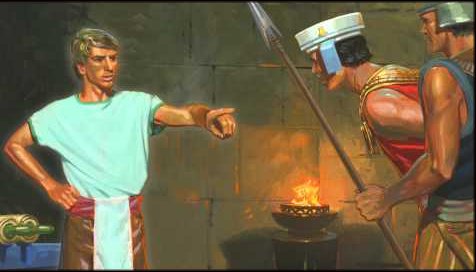 * Nehor judged guilty, confesses he taught people contrary to word of God, He is executed and suffers ignominious death upon the top of the hill Manti. His followers persecute those in the church. About 90 BC, Zarahemla - Second Year of Judges * Contentions arise, but Alma regulates the church. The people prosper, but more especially those who belong to the church. * Those not belonging to church of God began to persecute the humble members of the Church of God. Members begin to apostasy priests left their labors to impart word of God unto the people to combat conditions - peace restored and law executed properly |
* About 91 BC Ammon enters land of Ishmael and becomes Lamoni's servant Others deprat into other parts of the land to preach. * Sons of Mosiah been teaching the Lamanites for about 14 years (91-77 BC) About 77 BC Journeying likely from land of Aaron via Gideon to Manti (this is the noted 'short cut' Captain Moroni will later use), Alma meets up with sons of Mosiah journeying towards land of Zarahemla with people of Ammon (Anti-Nephi-Lehis) in tow. They relate their account to Alma. About 91-91 BC, among the Lamanites * The sons of Mosiah: Ammon, Aaron, Omner and Himni, preach amoung the Lamanites 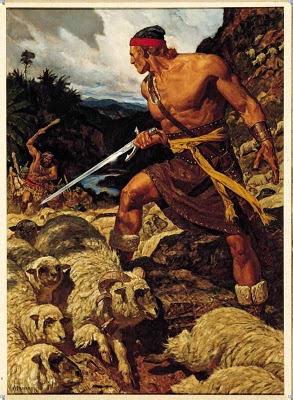
* Ammon has gone to the land of Ishmael and is taken captive. He is brought before the king, Lamoni. Ammon becomes Lamoni's servant and preserves the kings flocks. * Ammon is called before the king. Lamoni is converted and Ammon establishes a church in the land of Ishmael. * The Lord warns Ammon that Aaron and his brethern have been imprisoned in Middoni as they have not been as successful as Ammon. * Ammon and Lamoni journey to Middoni to free the prisoners. They meet Lamoni's father, king of all the Lamanites. Believing Ammon has deceived his son, Lamoni's father tries to slay Ammon. Ammon withstands the old king and persuades him to allow Lamoni to rule unhindered. The king sanctions release of Ammon's brethern as Ammon and Lamoni proceed to Middoni and free the prisoners. * After their release the spirit directs Aaron to visit Lamoni's father, who is troubled by the words of Ammon regarding repentance and salvation. Aaron teaches and converts the king and all his household. |
The Lamanite King's Proclamation of Religious Freedom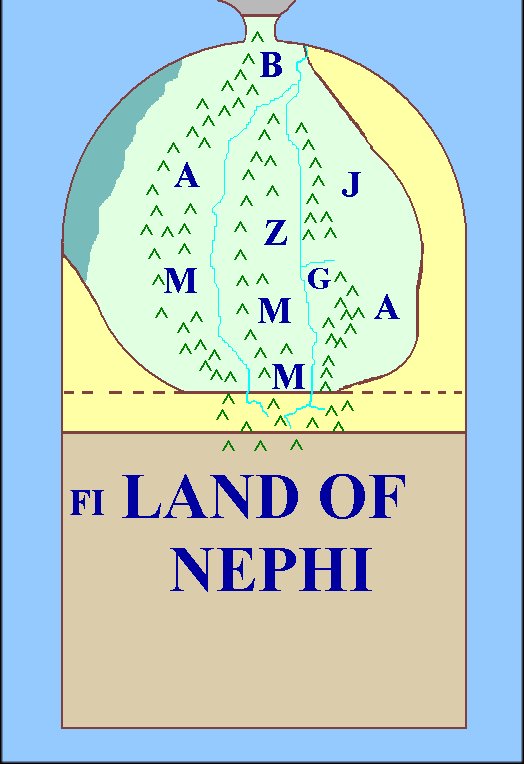 At the point where Lamoni's father declares 'religious freedom' and that the
Nephite missionaries should have full access to teach, Mormon inserts an
intrim description of the land. After Mormon relates that the king sent out a
proclamation throughout all the land of Nephi and the 'regions round about'
concerning the allowing of missionary work without fear of death or
persecution in Alma 22, Mormon takes the time in Alma 22:27-35 to give
a then (about 84/83 BC) contemporary general relational mapping of the
land of Zarahemla and Land of Nephi. These are the following characteristics
coupled with the same era information from Alma's preceedings in Zarahemla:
At the point where Lamoni's father declares 'religious freedom' and that the
Nephite missionaries should have full access to teach, Mormon inserts an
intrim description of the land. After Mormon relates that the king sent out a
proclamation throughout all the land of Nephi and the 'regions round about'
concerning the allowing of missionary work without fear of death or
persecution in Alma 22, Mormon takes the time in Alma 22:27-35 to give
a then (about 84/83 BC) contemporary general relational mapping of the
land of Zarahemla and Land of Nephi. These are the following characteristics
coupled with the same era information from Alma's preceedings in Zarahemla:
The last three such 'Church Provinces' are a bit nibulous to determine, but there are clues. Clue one comes when Alma was 'expelled' by the rule and law of the chief judge of Ammoniaha out of the land of Ammonihah. Some presume the city of Aaron that Alma was traveling to was some nearby city. However a second clue is that Alma had been going without food for some days and when the angel turned him about to return to the land of Ammonihah, by the time he again reached Ammonihah he was quite famished and 'the' angel had prepared Amulek to take him in and feed him. Later we hear again of the city of Aaron which is upon the east of the national lands of Zarahemla, and those who presumed that the city of Aaron Alma was traveling to was near Ammonihah further therefore presume there must be two cities of Aaron. Mormon in the Book of Mormon never tells them that. Under the logic of the 7 church provinces, Alma very well may have been journeying from those church provinces upon to west to some such other church province in the east. The one such eventually named land which the city of Aaron may have been the chief city of could be the land of Jershon and the eastern location of the city of Aaron correlates well with being so associated with the land of Jershon. In fact a 'concluding clue' could be that after Alma and Amulek return together to Zarahemla for a rest, they then go out and again start to preach to the people of the land and when it comes to Alma there after meeting up with the Sons of Mosiah returning from the land of Nephi with the people of Ammon, the Book of Mormon tells us that Alma is traveling via the land of Gideon towards the land of Manti. Now that route is the same 'shortcut' route that Captaim Moroni will take to next confront the Zoramite led Lamanites from his defensive line of defending Jershon when he has to beat the Lamanites to the land of Manti. Thus Alma with Amulek would seem to have gotten to the land of the City of Aaron which land it would appear was Jershon. As to the other two provincial church land of the 7 Churches there are three canidates and depending when they were established by this later date the count of 7 may have risen to 8. Those three lands are the land of Manti which Alma and Amulek were headed towards when they met the sons of Mosiah returning from the land of Nephi, Antionum, which Alma does next organize a missionary effort to visit, and there is also the land of Bountiful which Mormon's general mapping of the national lands of Nephi and Zarahemla does mention. Those are the lands mentioned, as for the topology of the land there appears to be at least three sizeable rivers involved. There is of course the Sidon river, there is the branching river which forms the valley of Gideon to the east from the Sidon, which we can call the Gideon river. And then there is that water source and river which supports such as the land of Melek and Ammonihah. Remember Alma went west 'over into' Melek which implies a mountain range involved and also when Alma and Amulek came back from the city of Sidom in the land province of Ammonihah they came back 'over' to Zarahemla. I call that the Sidom river because of the city Sidom and since it kind of matches the river Sidon. With those two parallel rivers running from south to north it sort of sets up three parallel mountain ranges to support them and then of course a 'east canyon' valley for the river and valley of Gideon. With the central mountain or cordillera mountain range to rap around the city and land of Zarahemal upon the west and north, that would yield such as the wilderness of Hermounts. And with the western cordillera upon the west of such as Melek and Ammonihah, this would form the mountainous 'west wilderness' which the Lamnites utilized to travel in to enable them to make there surprise attack upon the city of Ammonihah and the Noah. And then the land and city of Bountiful are well established in the Book of Mormon as the land Bountiful runs up into and its northern reaches form the narrow neck of land upon the borders of the land of Desolation. And from default conclusions of why the Lamanites never seriously attempted a west coastal assult upon reaching the land northward, a natural land barrier may be presumed along the west coast shore line such as mangrove swamps etc. One final note about the configuration of the land here is to note that the 'land of first inheritance' is west along the shore line of the land of Nephi. This may be taken back to imply that Nephi did indeed travel east inland to escape his brethern who were seeking to take his life in the 5th chapter of 1 Nephi. And it may further be used to presume where a land of Lehi might be in relation to a land of Nephi which may have contributed to locate a city 'Lehi-Nephi' between upon the borders of that first land of Lehi of first inheritance and the land of Nephi's escape. With all the cities and lands of the land of Nephi which are never well positioned, it does give one something to at least start with. [See continued conversation concerning 'significant phrases' of this discription of the land by Mormon as found is Alma 22 compared to other statements also found in the Book of Mormon.] |
|
Fifth Year of Judges - War with Amlici and Lamanites |
|
|
About 87 BC - 5th year of Judges in Zarahemla
* Amlici, a follower of Nehor, and thus a likely associate with the Amulonites of the wicked priests of King Noah, is a cunning man, wise as to the world. He begins to be powerful, likely in league with the rebellious Lamanites and Nephites of the land of Nephi and therefore he endeavors to be king. * By the voice/vote of all the people Amlici is opposed and he did not become king. Never the less, his followers set him apart as their king. As such Amlici stirs up those in his favor and they gather together and prepare for war against the righteous Nephites. It would seem Amlici has a plan of deception in play with the rebellious Lamanites and the Nephites factions of the land of Nephi. * Amlici positions his army on the hill Amnihu on the east bank of the Sidon opposite of the city of Zarahemla daring the Nephite army to come out against him as he has began to make war against the Nephite upon the east bank. * This is exactly what Alma does. * With Alma leading the Nephites against Amlicites a great battle insues with 12,532 Amlicites killed and 6,562 Nephites killed. * The Amlicites flee southward perhaps appearing to be headed toward Gideon. Alma camps at the mouth of the valley of Gideon and sends out spies to assertain the Amlicites' indentions. * The spies find out that Amlici has crossed back over Sidon and joined with a great Lamanite army which 'just happen to be positioned above Minon,' which is south above the city of Zarahemla. *By the time Alma finds out from his spies, the joint Amlicite and Lamanite aries are marching through Minon on their way to Zarahemla. Alma rushes to meet them in battle before they can take the unprotected city of Zarahemla. He crosses Sidon just to the south of Zarahemla, 'heads off', (apparently to their side and rear) the joint enemy army and drives the Lamanites and Amlicites into wilderness of wild beasts called Hermounts to the west and north of Zarahemla. * The slain of the Amlicites and Lamanites are cast into river Sidon and their bones carried down into the depths of the sea In a subsequent battle another army of Lamanites are drive out of the borders of the national lands of Zarahemla and thus ended the 5th year of reign of judges. |
About 87 BC, In the land of Nephi
* There seems to be an unrecorded strategy afoot. In the land of Nephi many Lamanites, descendant of Laman and the disaffected Nephites of the priests of King Noah (Amulonites) and another undocumented Nephite discenter group [Amalikites], are unsatisfied with the Lamanite King's proclamation. The abridged Book of Mormon does not record it but the circumstance of 'coincidence' highly suggests it. A plan seems to have been hatched between these unsatistified 'Lamanite' factions and Amlici in Zarahemla. * Now the history of the sons of Mosiah does not touch upon these happenings, so they are but deduced from events of the time and what does happen in the land of Zarahemla. 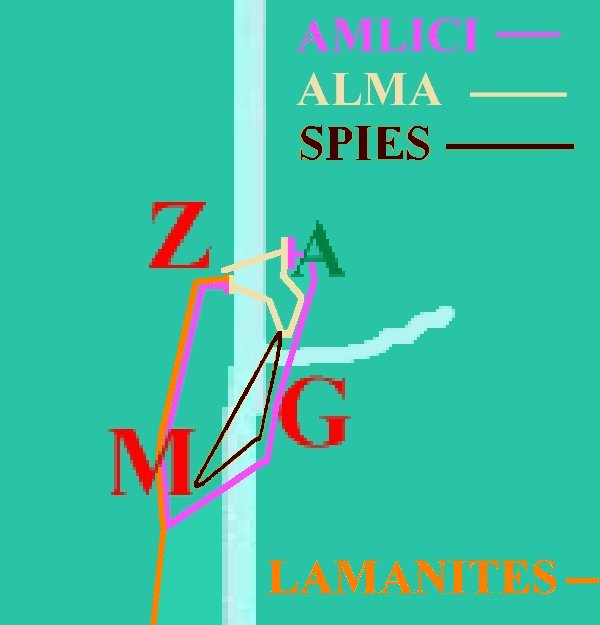
* It seems that Amlici has drawn out (or drawn in) the army of the Nephites under Alma to vacate the captial city of Zarahemla in order to pursue Amlici. * After camping for the evening of the pursuit Alma sends out 'spies to follow Amlici. They find that Amlici's and the Lamanite's have joined and have a plan that would have worked, that is Zarahemla would have been theirs and the decenting Nephites' and Lamanites' joint coalition would have been in power and in possession of the city of Zarahemla with the Army of Alma displaced and ousted out. * Amlici had 'fled to above Minon, having led Alma's army in the mouth of Gideon valley on the west side of the river Sidon. Amlici there above Minon has met up with the Lamanite factions army and from their march was directly through Minon toward Zarahemla. Only due to the spies' report is Alma able to rush back to Zarahemla to protect it but even then he is on the 'wrong' side of the river. (See Story at left) |
|
Between 86 and 84 BC, Zarahemla
|
Between 86 and 84 BC, Land of Nephi
* During this span of 3 years the rebellous Lamanites and Nephite factions are left licking their wounds of the failed attempt of 87 BC. The unincumbered missionary effort has produced much success in the lands of Ishmael and with many Lamanites, but not with the disinfected Nephite descenting groups. Religious freedom is granted to all Lamanites. The Lamanites in the lands of Ishmael and Middoni, the city of Nephi, and several other cities are converted. The Amalekites [Likely a Nephite desented group from days of Mosiah I not accounted for due to lost 116 pages etc.] and the Amulonites [Those Priests of wicked king Noah], Nephite dissenters living among the Lamanites, are not converted. |
|
Between 83 and 81 BC Alma resigns as chief Judge and appoints Nephihah in his stead Alma retains the office of prophet and high priest in order to combat the pride and dissensions in the church. * 83-82 BC. Alma preaches in Zarahemla, Gideon and Melek. * 82 BC: Alma preaches in Ammonihah but is rejected. An angel commands him to return. He is joined by Amulek and they preach again to the peope of Ammonihah. * Zeezrom contends with Alma but is silenced, fearing he has sinned. * Alma and Amulek are imprisoned. The people of Ammonihah martyr the believers among them and burn the scriptures. * 81 BC: Alma and Amulek are miraculously deliverd from the prison and their persecutors are slain. * Alma and Amulek preach in Sidom. Alma heals Zeezrom. * Alma and Amulek return to Zarahemla. * 9th year/83 BC Alma selects Nephihah appointed chief Judge Alma as High Priest - devotes himself to the ministry * 83 BC Alma delivers word of God to people of land of Zarahemla * 83 BC Alma ordains priest and elders to preside and watch over the church many repent and are baptized * 83 BC Alma goes to Valley of Gideon and preaches and is accepted and sucessful *82 BC Alma goes over into the land of Melek to preach and is accepted and is successful there. *82 BC Alma journeys likely by 'river' three days north to land of Ammonihah not successful and cast out of the land. Alma of the mind to turn his back on this 'land' forever (Alma 8:24) departs thence and takes his jorney towards the city of Aaron (Alma 8:13). Lord intervenes and sends Alma back and arranges Amulek to be there to feed, assist and also preach with Alma in Ammonihah - 'repent or be destroyed'. About 82 BC Alma preaches repentance and that the Son of God cometh. Unrighteous lawyers and judges of Ammonihah lay foundation for destruction of the people of Ammonihah. Alma/Amulek encounter Zeezrom over Son of God and but one God entrapment Teach of Melchizedek * 82-81 BC Alma/Amulek imprisoned - the wicked men of Ammonihah murder and burn by fire the believers - God delivers Alma/Amulek from prison * 81 BC Alma and Amulek commanded by Lord to depart Ammonihah and come over to land of Sidom where they found all the people who had departed having been cast out and stoned becaused they believed. * Zeezrom lay sick at Sidom, converted but plagued by guilt of conscience * Alma/Amulek come over to the land of Zarahemla - end 10th year of judges. |
* The converted Lamanites call themselves the Anti-Nephi-Lehies [meaning not descended from Nephi but descended from Lehi]. Lamoni's father dies. * The unconverted Lamanites prepare to make war against the Anti-Nephi-Lehies. The Lamanite converts reiterate their refusal to take up arms, even to defend themselves. * The Lamanites attack the Anti-Nephi-Lehies, but desist when the Anti-Nephi-Lehies refuse to defend themselves. Many of the attackers are converted. |
The Sound of War In the Land - 81 BC
|
|
|
About 81 BC
* An army of Lamanites, following the abortive attack on the Anti-Nephi-Lehies, attack and destroy the city of Ammonihah and take captives from the city of Noah. * Zoram, commander of Nephite army enquires of the prophet Alma where to go to find the Lamanites and rescue the captive Nephites of the city of Noah. * Alma tells Zoram he can head them off above Manti at the crossing of the river Sidon. * Zoram leads the Nephite army to victory over the Lamanites recovering the captives of Noah and driving the Lamanites back into the land of Nephi. |
About 81 BC
* Lamanites frustrated by non-combatant posture of their brethren turn instead to come up against the Nephites. * Whether knowingly or by that error which sent Lemhi's explorers astray into the land of Desolation, the Lamanites take a far west wilderness route into the land of Zarahemla and happen to come out at about the land of and city of Ammonihah. They may have considered it to be the city of Zarahemla. * Lamanites proceed to utterly destroy the city of Zarahemla and then they proceed to the city of Noah and take many of the Nephites of that city into captivity. * Lamanites retreat back along western wilderness route again avoiding the land of Melek/[presumed Minon] and then take course east and south above Manti crossing over the upper-upper extent of the river Sidon. * It is there that the army of Zoram comes upon the Lamanites, rescues the captive Nephites and drives the Lamanites back into their land. |
|
Between 80 and 77 BC, Zarahemla
* Alma and Amulek resume preaching to the people, likely turning to the eastern quarter of land of Jershon and its leading city of Aaron where Alma was headed when turned back by an angel to return to Ammonihah. |
Between 80 and 77 BC, among the Lamanites
* Many more Lamanites are converted and join the Anti-Nephi-Lehies. * The Amalekites seek to convince the Lamanites to avenge their losses by attacking the Anti-Nephi-Lehies again. * Ammon is directed by the Lord to lead the Anti-Nephi-Lehies to the land of Zarahemla. As they are journeying, the sons of Mosiah meet Alma and are re-united. * The Anti-Nephi-Lehies are received by the Nephites and given the land of Jershon. They are now called the people of Ammon, or Ammonites. |
|
Between 81 BC - 77 BC * 11th year of judges 5th day second month 'war in the land' - Lamanites come in upon wilderness side into borders of the land even into the city of Ammonihah, begin to slay and destroy the people. Before Nephites could raise army Ammonihah destroyed and Lamanites upon city of Noah and taken many captive into the wilderness. * man named Zoram chief captain Nephites with sons Lehi and Aha ask Alma the prophet where to go in search of Lamanites with captive Nephites. * Lord tells Alma away beyond the border of the land of Manti and meet them on the east of the river Sidon. * There Zoram meet Lamanites and recover captives of city of Noah and drove Lamanites out of land. (Those of Ammonihah were of the Nehors and the destroyed city was called Desolation of Nehors - Priestcraft as was under king Noah. * Alma Amulek went forth preaching repentance in their temples, sanctuaries and Synagogues built after manner of the Jews. Likely in land of Aaron where Alma was previously headed Etc. |
|
|
Between AD 401 and 421* (*Moroni 10:1)
* AD 401-421 Moroni produces the brief abridgment of the 24 plates of Ether called the the book of Ether. Moroni also addes some items reative to the church performances of baptism and the sacrement. He also addes some teaching and two letters he had received and kept all this time from his father Mormon (Moroni 7, 8, & 9). And then he wrote his own final farwell chapter of Moroni 10. * AD 421 Then at this final date, Moroni, as directed of God, would have prepared the stone box and place those items in it as later to be 'found' by the prophet Joseph Smith. |
|
Significant Phrases Cross-referenced and Discussed
The Land Bountiful and the Narrow Neck |
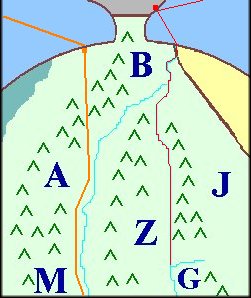 The Prophet Joseph Smith taught according to the Times and Seasons and also
as referenced by Apostle and Prophet Joseph Field Smith (TPJS p. 267), that
Lehi did sail
from that first land of Bountiful in the east across the Pacific Ocean and
landed 'a little south of the Isthmus of Darien'. From such a landing site
in that second land of Bountiful of the land of promise, Lehi's party would
have had to journey south, likely along the western parallel river valley
up and into that land and western coast line into that land which the Book
of Mormon calls their land of first inheritance on the west coast of the land
of Nephi. Traveling the western valley would have kept Lehi from running into
Mulek's party in Zarahemla if they had been contemporarily there. It is also
the likely answer to how the explores of Lemhi missed the city of Zarahemla
and mistakenly wondered up into the land of Desolation. They would have also
journeyed in the western parallel valley by mistake rather than the valley of
Sidon and of Zarahemla. It is like working a jigsaw puzzle or weaving a
tapestry, when done right the picture of what is so simply begins to appear.
There is even the fitting appearance of the wilderness of Hermounts and it
being infested by wild and ravenous beasts, which was to the west and
north of the local city and provincial land of Zarahemla between Zarahemla
and Bountiful further to the north (Alma 2:27).
The Prophet Joseph Smith taught according to the Times and Seasons and also
as referenced by Apostle and Prophet Joseph Field Smith (TPJS p. 267), that
Lehi did sail
from that first land of Bountiful in the east across the Pacific Ocean and
landed 'a little south of the Isthmus of Darien'. From such a landing site
in that second land of Bountiful of the land of promise, Lehi's party would
have had to journey south, likely along the western parallel river valley
up and into that land and western coast line into that land which the Book
of Mormon calls their land of first inheritance on the west coast of the land
of Nephi. Traveling the western valley would have kept Lehi from running into
Mulek's party in Zarahemla if they had been contemporarily there. It is also
the likely answer to how the explores of Lemhi missed the city of Zarahemla
and mistakenly wondered up into the land of Desolation. They would have also
journeyed in the western parallel valley by mistake rather than the valley of
Sidon and of Zarahemla. It is like working a jigsaw puzzle or weaving a
tapestry, when done right the picture of what is so simply begins to appear.
There is even the fitting appearance of the wilderness of Hermounts and it
being infested by wild and ravenous beasts, which was to the west and
north of the local city and provincial land of Zarahemla between Zarahemla
and Bountiful further to the north (Alma 2:27).
 Perhaps a most telling historical reference relative to this 'day and a half
journey' is to be found in recorded history. William Dampier, buccaneer,
navigator and explorer reports in his text "A New Voyage Round the
World", publisehed by him in 1697 as an English sea captain, naturalist
and occasional buccaneer the fact that a 'Miskito (Mosquito) Indian could
transverse
the narrow isthmus of Darien in one day and a half.' The added Book of Mormon
fact that it was 'from the east to the west' when compared to a well
mapped rendition of the area of the Darien may suggest just how this could
be accomplished as the main river of the Isthmus of the Darien flows from
east to west. Lewis and Clarke during their return journey of the fameous
exploration records that by canoeing down river they could cover over 70
miles distance in a day's time. Perhaps this is the key to transversing the
Darien and the narrow neck of land in such limited times.
Perhaps a most telling historical reference relative to this 'day and a half
journey' is to be found in recorded history. William Dampier, buccaneer,
navigator and explorer reports in his text "A New Voyage Round the
World", publisehed by him in 1697 as an English sea captain, naturalist
and occasional buccaneer the fact that a 'Miskito (Mosquito) Indian could
transverse
the narrow isthmus of Darien in one day and a half.' The added Book of Mormon
fact that it was 'from the east to the west' when compared to a well
mapped rendition of the area of the Darien may suggest just how this could
be accomplished as the main river of the Isthmus of the Darien flows from
east to west. Lewis and Clarke during their return journey of the fameous
exploration records that by canoeing down river they could cover over 70
miles distance in a day's time. Perhaps this is the key to transversing the
Darien and the narrow neck of land in such limited times.
 Book of Mormon scholars associate the reference in Helaman with that
found in Alma concerning the time to transverse the narrow neck. A careful
reading of the two verses will pose a different meaning. The Alma 22:32
description is concerning the transversing of the narrow neck in a day and a
half. The second verse in
Helamen speaks but of a defensive line. In Helaman they are defending a
certain defined line. A Unique feature of that region is a 12 mile long
significantly raised man made barier which reaches from mountainous foot
hills to moutainous foothills in the lower Darien interior region as
pictured. The fortified city of Bountiful would defended the eastern sea
coast passage and with the aid of the mountains, the interior defensive line
from mountain to mountain would defend the other route of access. That
defensive line distance may be covered by a foot sholdier in a day.
Book of Mormon scholars associate the reference in Helaman with that
found in Alma concerning the time to transverse the narrow neck. A careful
reading of the two verses will pose a different meaning. The Alma 22:32
description is concerning the transversing of the narrow neck in a day and a
half. The second verse in
Helamen speaks but of a defensive line. In Helaman they are defending a
certain defined line. A Unique feature of that region is a 12 mile long
significantly raised man made barier which reaches from mountainous foot
hills to moutainous foothills in the lower Darien interior region as
pictured. The fortified city of Bountiful would defended the eastern sea
coast passage and with the aid of the mountains, the interior defensive line
from mountain to mountain would defend the other route of access. That
defensive line distance may be covered by a foot sholdier in a day.